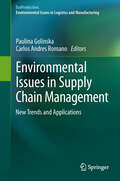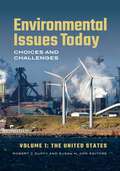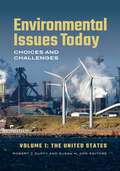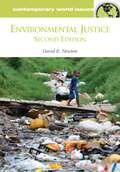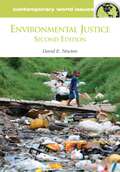- Table View
- List View
Environmental Instrumentation (Springer Advanced Texts in Life Sciences)
by Leo J. Fritschen Lloyd W. GayThe rapid increase in environmental measurements during the past few decades is associated with (1) increasing awareness of the complex relations linking biological responses to atmospheric variables, (2) development of improved data acquisition and handling equipment, (3) the application of modeling to environmental problems, and (4) the implementation of large, cooperative studies of international scope. The consequences of man's possible alteration of the environment have increased our interest in the complex nature of biological responses to meteorological variables. This has generated activity in both measurements and in the application of modeling techniques. The virtual explosion of modeling activity is also associated with the development oflarge computers. The testing of these models has demonstrated the need for more, different, and better environmental data. In addition, technological developments, such as integrated circuits, have reduced the cost, power consumption, and complexity of data acquisition systems, thus promoting more environmental measurements. The emergence of scientific cooperation on a global scale has increased measurement activities markedly. The International Geophysical Year (1958) has been followed by the International Hydrologic Decade, the Inter national Biological Program, the Global Atmospheric Research Program, and a host of environmental studies of a regional nature that have all emphasized field data collection.
Environmental Instrumentation and Analysis Handbook
by Randy D. Down Jay H. LehrA comprehensive resource for information about different technologies and methods to measure and analyze contamination of air, water, and soil. * Serves as a technical reference in the field of environmental science and engineering * Includes information on instrumentation used for measurement and control of effluents and emissions from industrial facilities that can directly influence the environment * Focuses on applications, making it a practical reference tool
Environmental Interactions of Clays: Clays and the Environment
by Dr Andrew ParkerThis companion volume to Velde's Origin and Mineralogy of Clays deals with the role of clays in specific environmental issues, and is unique in its subject matter. Individual chapters are written by recognized international experts in their field, and cover such subjects as radioactive waste disposal, trace metals, soil quality and productivity, pesticides, landfill, fibrous minerals and health. The approach combines reviews with current research, making it an invaluable resource for students, researchers and practitioners alike.
Environmental Investigation and Remediation: 1,4-Dioxane and other Solvent Stabilizers, Second Edition
by Thomas K.G. Mohr William H. DiGuiseppi James W. Hatton Janet Katherine AndersonFilled with updated information, equations, tables, figures, and citations, Environmental Investigation and Remediation: 1,4-Dioxane and Other Solvent Stabilizers, Second Edition provides the full range of information on 1,4-dioxane. It offers passive and active remediation strategies and treatment technologies for 1,4-dioxane in groundwater and provides the technical resources to help readers choose the best methods for their particular situation. This new edition includes all new information on remediation costs and reflects the latest research in the field. It includes new practical case studies to illustrate the concepts presented, including 1,4-dioxane occurrence in Long Island and the Cape Fear watershed in North Carolina. Features: Fully updated throughout to reflect the most recent research on 1,4-dioxane Describes the nature and extent of 1,4-dioxane releases, their regulation, and their remediation in a variety of geologic settings Examines 1,4-dioxane analytical chemistry, its many industrial uses, and 1,4-dioxane occurrence as a byproduct in production of many products Provides ample site data for recent and relevant remediation case studies, and a review of the widely varying regulatory landscape for 1,4-dioxane cleanup levels and drinking water limits Discusses the importance of accounting for contaminant archeology in investigating contaminated sites, and leveraging solvent stabilizers in forensic investigations While written primarily for practicing professionals, such as environmental consultants and attorneys, water utility engineers, and laboratory managers, the book will also appeal to researchers and academics as well. This new edition serves as a highly useful reference on the occurrence, sampling and analysis, and remedial investigation and design for 1,4-dioxane and related contaminants.
Environmental Investigation and Remediation: 1,4-Dioxane and other Solvent Stabilizers, Second Edition
by Thomas K.G. Mohr William H. DiGuiseppi James W. Hatton Janet Katherine AndersonFilled with updated information, equations, tables, figures, and citations, Environmental Investigation and Remediation: 1,4-Dioxane and Other Solvent Stabilizers, Second Edition provides the full range of information on 1,4-dioxane. It offers passive and active remediation strategies and treatment technologies for 1,4-dioxane in groundwater and provides the technical resources to help readers choose the best methods for their particular situation. This new edition includes all new information on remediation costs and reflects the latest research in the field. It includes new practical case studies to illustrate the concepts presented, including 1,4-dioxane occurrence in Long Island and the Cape Fear watershed in North Carolina. Features: Fully updated throughout to reflect the most recent research on 1,4-dioxane Describes the nature and extent of 1,4-dioxane releases, their regulation, and their remediation in a variety of geologic settings Examines 1,4-dioxane analytical chemistry, its many industrial uses, and 1,4-dioxane occurrence as a byproduct in production of many products Provides ample site data for recent and relevant remediation case studies, and a review of the widely varying regulatory landscape for 1,4-dioxane cleanup levels and drinking water limits Discusses the importance of accounting for contaminant archeology in investigating contaminated sites, and leveraging solvent stabilizers in forensic investigations While written primarily for practicing professionals, such as environmental consultants and attorneys, water utility engineers, and laboratory managers, the book will also appeal to researchers and academics as well. This new edition serves as a highly useful reference on the occurrence, sampling and analysis, and remedial investigation and design for 1,4-dioxane and related contaminants.
Environmental Ion Exchange: Principles and Design, Second Edition
by Anthony M. WachinskiThis book will contain the most important ion exchange-related design and application issues. Using tables, graphs, and conversion tables, it will explain the fundamentals, providing the knowledge to use ion exchange to reuse wastewaters, recover valuable chemicals, and recycle industrial waters. For anyone who is designing unconventional ion exchange systems, or who needs a fundamental knowledge of ion exchange, this is the perfect working reference. This new edition will be updated throughout, add a new chapter (Selective Ion Exchange Resins), and include all new information on the removal of boron, arsenic, nitrates, ammonia, radioactivity, silica, and heavy metals from water.
Environmental Ion Exchange: Principles and Design, Second Edition
by Anthony M. WachinskiThis book will contain the most important ion exchange-related design and application issues. Using tables, graphs, and conversion tables, it will explain the fundamentals, providing the knowledge to use ion exchange to reuse wastewaters, recover valuable chemicals, and recycle industrial waters. For anyone who is designing unconventional ion exchange systems, or who needs a fundamental knowledge of ion exchange, this is the perfect working reference. This new edition will be updated throughout, add a new chapter (Selective Ion Exchange Resins), and include all new information on the removal of boron, arsenic, nitrates, ammonia, radioactivity, silica, and heavy metals from water.
Environmental Ion Exchange: Principles and Design
by Anthony M. Wachinski James E. EtzelEnvironmental Ion Exchange: Principles and Design contains the most important ion exchange-related design and application issues. Using tables, graphs, and conversion tables, this book teaches you the basics, giving you the knowledge to use ion exchange to reuse, recover, and recycle. This hands-on guide explains how to apply ion exchange to reuse
Environmental Issues in Automotive Industry (EcoProduction)
by Paulina GolinskaThe automotive industry is one of the most environmental aware manufacturing sectors. Product take-back regulations influence design of the vehicles, production technologies but also the configuration of automotive reverse supply chains. The business practice comes every year closer to the closed loop supply chain concept which completely reuses, remanufactures and recycles all materials. The book covers the emerging environmental issues in automotive industry through the whole product life cycle. Its focus is placed on a multidisciplinary approach. It presents viewpoints of academic and industry personnel on the challenges for implementation of sustainable police in the automotive sector
Environmental Issues in China Today: A View from Japan (Advances in Asian Human-Environmental Research)
by Hidefumi ImuraEconomic development and environmental issues in China are attracting more and more attention internationally as the country’s large population and vast demands for food, energy, water, minerals, and other resources play an increasingly important role in deciding the fate of the world. There is great interest in learning more about environmental issues in China, but it is not easy to obtain accurate, relevant information because the issues are diverse and are complex phenomena resulting from the interconnections among natural resource constraints and political, social, and institutional systems. This book originally was published in Japanese with the aim of providing Japanese readers with a holistic picture of what was taking place in China with respect to its air, water, energy, and land. The author then prepared an English edition of the same material to use as a book of readings for the Global Environmental Leaders Program at Nagoya University, where he taught many students from Asia and Europe. The book covers the most important environmental issues in China—climatic change, water, air, energy, and resources—together with ongoing policy responses, based on the author’s active involvement in a number of study projects and international cooperation projects in that country. This volume will help readers to understand the causes and results of environmental problems in China and will encourage them to think more deeply about the environmental implications of the country’s rapid economic growth.
Environmental Issues in Latin America and the Caribbean
by Aldemaro Romero Sarah E. WestThis book is a collection of readings that explore environmental issues in Latin America and the Caribbean using natural science and social science methods. These papers demonstrate the value of interdisciplinary approaches to analyze and solve environmental problems. The essays are organized into five parts: conservation challenges; national policies, local communities, and rural development; market mechanisms for protecting public goods; public participation and environmental justice; and the effects of development policies on the environment.
Environmental Issues in Supply Chain Management: New Trends and Applications (EcoProduction)
by Paulina Golinska and Carlos Andres RomanoThe aim of the book is to present the emerging environmental issues in organization and management of complex supply chains. The book includes set of solutions which show different stakeholders' viewpoints on sustainability. The scope of book takes into consideration how the emerging environmental regulation might be transformed into business practices. Therefore, the authors present the innovative approach to eco-friendly organization and coordination of logistics processes and supply chain configuration. A broad scope of practical solutions from different countries and industries is provided
Environmental Issues of Deep-Sea Mining: Impacts, Consequences and Policy Perspectives
by Rahul SharmaThis volume discusses environmental issues associated with deep-sea mining, with an emphasis on potential impacts, their consequences and the policy perspectives. The book describes the methods and technologies to assess, monitor and mitigate mining impacts on marine environments, and also suggests various approaches for environmental management when conducting deep-sea mining. The volume brings together information and data for researchers, contractors, mining companies, regulators, and NGOs working in the field of deep-sea mining. Section 1 highlights the various environmental issues and discusses methods and approaches that can help in developing environmentally sustainable deep-sea mining. Section 2 details the results and outcomes of studies related to impact assessment of deep-sea mining, and proposes methods for monitoring. Section 3 discusses the need and means for developing data standards and their application to deep-sea mining. Section 4 discusses the policies, approaches, and practices related to deep-sea mining, suggests formats for developing environmental impact statements (EIS) and environmental management plans (EMP), and describes national and international regulations for environmental management. Section 5 concludes the text by putting deep-sea economic activities into an environmental context and conducting techno-economic analyses of deep-sea mining and processing.
Environmental Issues Today [2 volumes]: Choices and Challenges [2 volumes]
by Robert J. Duffy and Susan M.This two-volume set provides an authoritative overview of the major environmental issues of the 21st century, with a special focus on current challenges, trends, and policy choices.This set provides an up-to-date, comprehensive, and focused resource for understanding the nature and scope of environmental challenges facing the United States and the world in the 21st century, as well as options for meeting those challenges. Volume One covers environmental trends and challenges within the United States, while Volume Two illuminates environmental issues and choices around the world. Issues covered in both volumes include vital topics such as climate change, air and water pollution, natural resource and species protection, and agricultural/industrial impacts on the environment and public health. For all topics, the authors—scholars and experts hailing from a wide range of environmental and policy fields—detail a range of political, social, and economic options for the future and explain why the issue in question is important for society and people as well as the natural world.
Environmental Issues Today [2 volumes]: Choices and Challenges [2 volumes]
This two-volume set provides an authoritative overview of the major environmental issues of the 21st century, with a special focus on current challenges, trends, and policy choices.This set provides an up-to-date, comprehensive, and focused resource for understanding the nature and scope of environmental challenges facing the United States and the world in the 21st century, as well as options for meeting those challenges. Volume One covers environmental trends and challenges within the United States, while Volume Two illuminates environmental issues and choices around the world. Issues covered in both volumes include vital topics such as climate change, air and water pollution, natural resource and species protection, and agricultural/industrial impacts on the environment and public health. For all topics, the authors—scholars and experts hailing from a wide range of environmental and policy fields—detail a range of political, social, and economic options for the future and explain why the issue in question is important for society and people as well as the natural world.
Environmental Justice: A Reference Handbook (Contemporary World Issues)
by David E. NewtonEnvironmental Justice: A Reference Handbook, Second Edition offers a current overview of the environmental inequities faced by poor and minority communities and the development of the grassroots movement working to address them.Building on the original edition's focus on the link between social inequalities and the uneven distribution of environmental hazards in the air, water, and soil, Environmental Justice: A Reference Handbook, Second Edition presents a contemporary look at the convergence of the environmental movement and civil rights activism.Environmental Justice, Second Edition follows the rise and maturation of the movement focused on environmental racism, describes solutions that have been implemented, and examines issues that remain unresolved. The book offers a wealth of new data and information, particularly in its expanded coverage of environmental disparities in developing countries and its rich bibliography of print and online resources.
Environmental Justice: A Reference Handbook (Contemporary World Issues)
by David E. NewtonEnvironmental Justice: A Reference Handbook, Second Edition offers a current overview of the environmental inequities faced by poor and minority communities and the development of the grassroots movement working to address them.Building on the original edition's focus on the link between social inequalities and the uneven distribution of environmental hazards in the air, water, and soil, Environmental Justice: A Reference Handbook, Second Edition presents a contemporary look at the convergence of the environmental movement and civil rights activism.Environmental Justice, Second Edition follows the rise and maturation of the movement focused on environmental racism, describes solutions that have been implemented, and examines issues that remain unresolved. The book offers a wealth of new data and information, particularly in its expanded coverage of environmental disparities in developing countries and its rich bibliography of print and online resources.
Environmental Justice: Creating Equality, Reclaiming Democracy (Environmental Ethics and Science Policy Series)
by Kristin Shrader-FrechetteShrader-Frechette offers a rigorous philosophical discussion of environmental justice. Explaining fundamental ethical concepts such as equality, property rights, procedural justice, free informed consent, intergenerational equity, and just compensation--and then bringing them to bear on real-world social issues--she shows how many of these core concepts have been compromised for a large segment of the global population, including Appalachians, African-Americans, workers in hazardous jobs, and indigenous people in developing nations. She argues that burdens like pollution and resource depletion need to be apportioned more equally, and that there are compelling ethical grounds for remedying our environmental problems. She also argues that those affected by environmental problems must be included in the process of remedying those problems; that all citizens have a duty to engage in activism on behalf of environmental justice; and that in a democracy it is the people, not the government, that are ultimately responsible for fair use of the environment.
Environmental Justice: Creating Equality, Reclaiming Democracy (Environmental Ethics and Science Policy Series)
by Kristin Shrader-FrechetteShrader-Frechette offers a rigorous philosophical discussion of environmental justice. Explaining fundamental ethical concepts such as equality, property rights, procedural justice, free informed consent, intergenerational equity, and just compensation--and then bringing them to bear on real-world social issues--she shows how many of these core concepts have been compromised for a large segment of the global population, including Appalachians, African-Americans, workers in hazardous jobs, and indigenous people in developing nations. She argues that burdens like pollution and resource depletion need to be apportioned more equally, and that there are compelling ethical grounds for remedying our environmental problems. She also argues that those affected by environmental problems must be included in the process of remedying those problems; that all citizens have a duty to engage in activism on behalf of environmental justice; and that in a democracy it is the people, not the government, that are ultimately responsible for fair use of the environment.
Environmental Justice in the New Millennium: Global Perspectives on Race, Ethnicity, and Human Rights
by F. SteadyEnvironmental Justice is one of the most important human rights challenges today. It refers to inequitable environmental burdens born by groups such as racial minorities, residents of economically disadvantaged areas, or residents of developing nations. This book explores this subject with case studies from various parts of the world.
Environmental Laboratory Exercises for Instrumental Analysis and Environmental Chemistry
by Frank M. DunnivantA comprehensive set of real-world environmental laboratory experiments This complete summary of laboratory work presents a richly detailed set of classroom-tested experiments along with background information, safety and hazard notes, a list of chemicals and solutions needed, data collection sheets, and blank pages for compiling results and findings. This useful resource also: Focuses on environmental, i.e., "dirty" samples Stresses critical concepts like analysis techniques and documentation Includes water, air, and sediment experiments Includes an interactive software package for pollutant fate and transport modeling exercises Functions as a student portfolio of documentation abilities Offers instructors actual samples of student work for troubleshooting, notes on each procedure, and procedures for solutions preparation.
Environmental Law and American Business: Dilemmas of Compliance (Environment, Development and Public Policy: Environmental Policy and Planning)
by Joseph F. DiMentoWe are in the second decade of modem environmental law. By some indicators this body of regulation has matured greatly. We can point to statutes and codes at the federal, state, and local levels which address almost every conceivable form of pollution and environmental insult. Yet, despite the existence of this large body of law, despite considerable expenditures on enforcement, and despite the energetic efforts of people sympathetic to environmental objectives, violations are numerous. Serious pollution problems are commonplace. Love Canal, the Valley of the Drums, Times Beach, and Stringfellow Acid Pits epitomize the national environmental quality challenge. Daily, a major illegal disposal of haz ardous waste is recorded; a new mismanaged dump site is discovered; a toxic substance is found in our drinking water; or a failure to meet a water or air quality standard is identified. Many of these violations involve American business. Failures to comply are of several types. A small businessman in Pennsylvania mistakenly allows a spillover of a pollutant into a protected stream. An industrialist in the Midwest adds to his fortune by illegally dumping dangerous chemicals. A series of errors by several firms, some of which no longer exist, combine to create a health threatening conflagration on the West Coast. An automobile company interprets one of the almost innumerable air pollution rules differently from government: It produces a car which the government says fails to comply with the Clean Air Act.
Environmental Law for Biologists
by Tristan KimbrellEnvironmental law has an unquestionable effect on the species, ecosystems, and landscapes that biologists study—and vice-versa, as the research of these biologists frequently informs policy. But because many scientists receive little or no legal training, we know relatively little about the precise ways that laws affect biological systems—and, consequently, about how best to improve these laws and better protect our natural resources. With Environmental Law for Biologists, ecologist and lawyer Tristan Kimbrell bridges this gap in legal knowledge. Complete with a concise introduction to environmental law and an appendix describing the most important federal and international statutes and treaties discussed, the book is divided into four broad parts: laws that focus on individual species, like invasive species policies, the Endangered Species Act, and international treaties such as CITES; laws that focus on land, from federal public lands to agricultural regulations and urban planning; laws that focus on water, such as the Clean Water Act; and laws that focus on air, such as the Clean Air Act and international measures meant to mitigate global climate change. Written for working biologists and students alike, this book will be a catalyst for both more effective policy and enhanced research, offering hope for the manifold frictions between science and the law.
Environmental Law for Biologists
by Tristan KimbrellEnvironmental law has an unquestionable effect on the species, ecosystems, and landscapes that biologists study—and vice-versa, as the research of these biologists frequently informs policy. But because many scientists receive little or no legal training, we know relatively little about the precise ways that laws affect biological systems—and, consequently, about how best to improve these laws and better protect our natural resources. With Environmental Law for Biologists, ecologist and lawyer Tristan Kimbrell bridges this gap in legal knowledge. Complete with a concise introduction to environmental law and an appendix describing the most important federal and international statutes and treaties discussed, the book is divided into four broad parts: laws that focus on individual species, like invasive species policies, the Endangered Species Act, and international treaties such as CITES; laws that focus on land, from federal public lands to agricultural regulations and urban planning; laws that focus on water, such as the Clean Water Act; and laws that focus on air, such as the Clean Air Act and international measures meant to mitigate global climate change. Written for working biologists and students alike, this book will be a catalyst for both more effective policy and enhanced research, offering hope for the manifold frictions between science and the law.
Environmental Law for Biologists
by Tristan KimbrellEnvironmental law has an unquestionable effect on the species, ecosystems, and landscapes that biologists study—and vice-versa, as the research of these biologists frequently informs policy. But because many scientists receive little or no legal training, we know relatively little about the precise ways that laws affect biological systems—and, consequently, about how best to improve these laws and better protect our natural resources. With Environmental Law for Biologists, ecologist and lawyer Tristan Kimbrell bridges this gap in legal knowledge. Complete with a concise introduction to environmental law and an appendix describing the most important federal and international statutes and treaties discussed, the book is divided into four broad parts: laws that focus on individual species, like invasive species policies, the Endangered Species Act, and international treaties such as CITES; laws that focus on land, from federal public lands to agricultural regulations and urban planning; laws that focus on water, such as the Clean Water Act; and laws that focus on air, such as the Clean Air Act and international measures meant to mitigate global climate change. Written for working biologists and students alike, this book will be a catalyst for both more effective policy and enhanced research, offering hope for the manifold frictions between science and the law.









